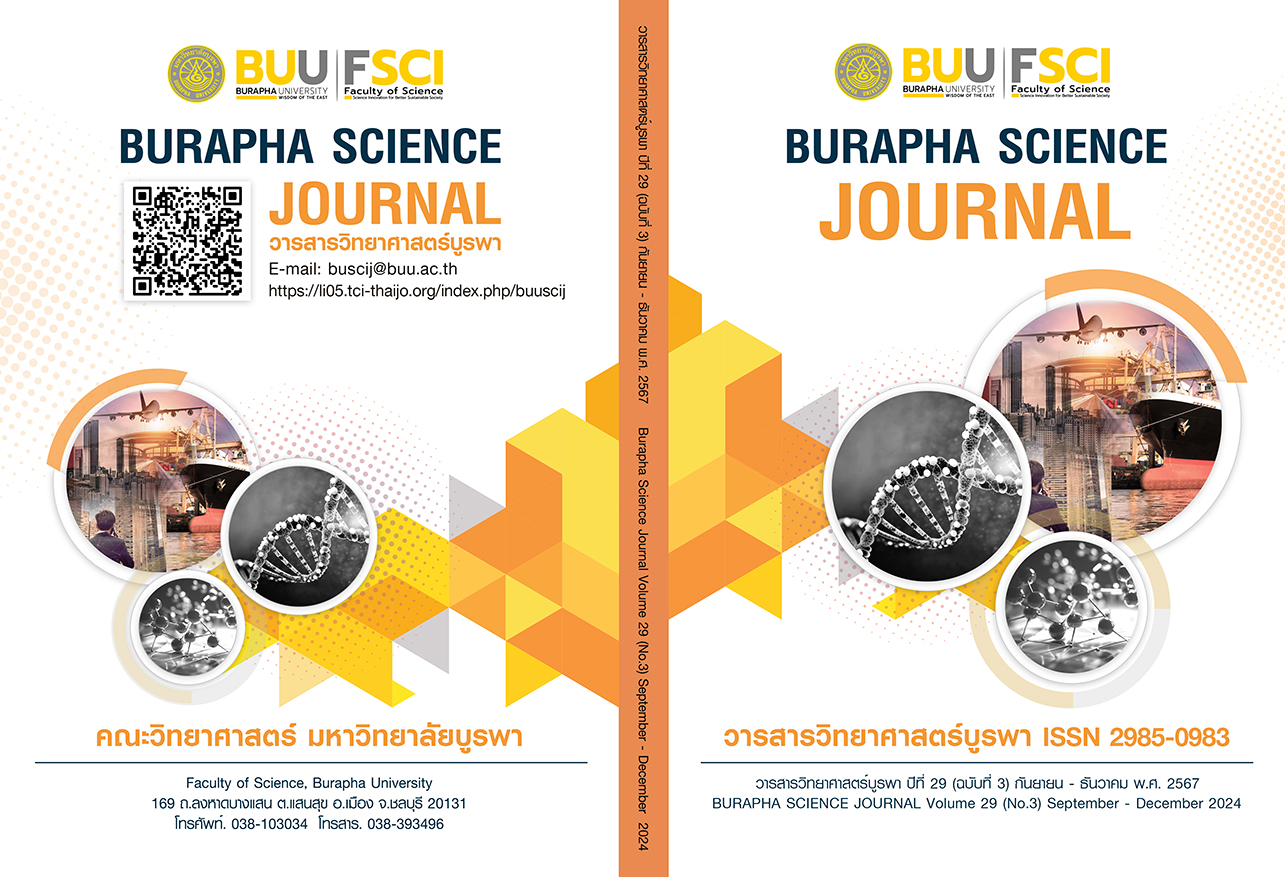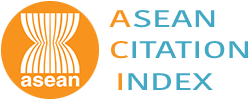การประเมินฤทธิ์ต้านอนุมูลอิสระและฤทธิ์ยับยั้งการเจริญของแบคทีเรีย ของสารสกัดหยาบฟรุติโคสไลเคนสกุล Usnea
คำสำคัญ:
การต้านอนุมูลอิสระ , การยับยั้งแบคทีเรีย , สารสกัดหยาบ , ไลเคนบทคัดย่อ
วัตถุประสงค์และที่มา : งานวิจัยนี้มีวัตถุประสงค์เพื่อประเมินศักยภาพการต้านอนุมูลอิสระ การยับยั้งแบคทีเรีย และวิเคราะห์ปริมาณสารประกอบฟีนอลิกรวม ฟลาโวนอยด์รวม และแทนนินของสารสกัดหยาบฟรุติโคสไลเคนสกุล Usnea
วิธีดำเนินการวิจัย : นำไลเคนสกุล Usnea มาสกัดด้วยตัวทำละลาย 4 ชนิด ได้แก่ เอทานอลร้อยละ 95 อะซิโตน เอทิลอะซิเตท และน้ำร้อน การวิเคราะห์ฤทธิ์ต้านอนุมูลอิสระด้วยวิธี DPPH ABTS และ FRAP assay ส่วนการทดสอบการยับยั้งแบคทีเรียด้วยวิธี Agar well diffusion และวิธี Broth microdilution ในการหาความเข้มข้นต่ำสุดที่ยับยั้งแบคทีเรีย (Minimum Inhibitory Concentration; MIC) และ ความเข้มข้นต่ำสุดที่ฆ่าแบคทีเรีย (Minimum Bactericidal Concentration; MBC)
ผลการวิจัย : ผลการวิเคราะห์พบว่าสารสกัดด้วยน้ำร้อนมีฤทธิ์ต้านอนุมูลอิสระดีที่สุดในทั้ง 3 วิธี โดย DPPH assay มีค่า IC50 เท่ากับ 0.741±0.021 มิลลิกรัมต่อมิลลิลิตร วิธี ABTS assay มีค่า IC50 เท่ากับ 1.001±0.005 มิลลิกรัมต่อมิลลิลิตร และในวิธี FRAP assay มีค่า FRAP value เท่ากับ 27.927±0.129 มิลลิกรัมเฟอรัสซัลเฟตต่อกรัมสารสกัดหยาบตามลำดับ การทดสอบการยับยั้งแบคทีเรีย พบว่าสารสกัดด้วยเอทานอลร้อยละ 95 อะซิโตน และเอทิลอะซิเตท สามารถยับยั้งแบคทีเรีย Bacillus cereus TISTR 1449, Staphylococcus epidermidis TISTR 2162 และ Escherichia coli TISTR 527 ได้ แต่ไม่สามารถยับยั้งการเจริญของ Pseudomonas aeruginosa TISTR 1287 สารสกัดหยาบด้วยเอทานอลร้อยละ 95 สามารถยับยั้งและฆ่าแบคทีเรียทั้งสามชนิด มีค่า MIC และ MBC เท่ากับ 20 มิลลิกรัมต่อมิลลิลิตร ส่วนสารสกัดหยาบด้วยน้ำร้อนมีฤทธิ์ยับยั้งและฆ่าแบคทีเรียชนิดเดียวคือ B. cereus TISTR 1449 มีค่า MIC และ MBC เท่ากับ 40 มิลลิกรัมต่อมิลลิลิตร สารสกัดด้วยเอทานอลร้อยละ 95 พบปริมาณสารประกอบฟีนอลิกรวม ฟลาโวนอยด์ และแทนนินสูงที่สุดเท่ากับ 93.772±2.847, 36.847±0.613, 90.467±2.784 มิลลิกรัมต่อกรัมสารสกัดหยาบ ตามลำดับ
สรุปผลการวิจัย : งานวิจัยนี้เป็นรายงานการทดสอบฤทธิ์ต้านนอุมูลอิสระและยับยั้งแบคทีเรียของไลเคนสกุล Usnea จากการศึกษางานวิจัยนี้ให้ข้อมูลเชิงลึกอันมีค่าที่เป็นแนวทางสำหรับการพัฒนาและการประยุกต์ใช้ในอนาคตในอุตสาหกรรมยาและอาหาร ช่วยเพิ่มการใช้ผลิตภัณฑ์จากธรรมชาติมากขึ้น
เอกสารอ้างอิง
Aydin, S., Kinalioğlu, K., & Sökmen, B. B. (2018). Antioxidant, anti-urease, and anti-elastase activities of Usnea longissima Ach. Bangladesh Journal of Botany, 47(3), 429-435.
Buaruang, K., Boonpragob, K., Mongkolsuk, P., Sangvichien, E., Vongshewarat, K., Polyiam, W., & Lumbsch, T. (2017). A new checklist of lichenized fungi occurring in Thailand. MycoKeys, 23, 1.
Daupor, Saha, Chelong, Meechai & Waema. (2017). Determination of Total Flavonoid Content from Propolis Stingless Bee and Bacterial Inhibition of Escherichia coli in Soap Product. In The Sixth National Conference. Fatoni University, Yala. (in Thai)
Dieu, A., Mambu, L., Champavier, Y., Chaleix, V., Sol, V., Gloaguen, V., & Millot, M. (2020). Antibacterial activity of the lichens Usnea Florida and Flavoparmelia caperata (Parmeliaceae). Natural product research, 34(23), 3358-3362.
Farha, A. K., Yang, Q. Q., Kim, G., Li, H. B., Zhu, F., Liu, H. Y., & Corke, H. (2020). Tannins as an alternative to antibiotics. Food Bioscience, 38, 100751.
Fernandes, P. A., & Coimbra, M. A. (2023). The antioxidant activity of polysaccharides: A structure-function relationship overview. Carbohydrate Polymers, 314, 120965.
Funk, E. R., Adams, A. N., Spotten, S. M., Van Hove, R. A., Whittington, K. T., Keepers, K. G., & Kane, N. C.(2018). The complete mitochondrial genomes of five lichenized fungi in the genus Usnea (Ascomycota: Parmeliaceae). Mitochondrial DNA Part B, 3(1), 305-308.
Goel, M., Singh, R., Kumar, A., & Singh, S. (2021). Inhibition of penicillin-binding protein 2a (PBP2a) in methicillin-resistant Staphylococcus aureus (MRSA) by combination of oxacillin and a bioactive compound from Ramalina roesleri. Microbial Pathogenesis, 150, 104676.
Jannah, M., Hariri, M. R., Kasiamdari, R. S., & Handayani, N. S. N. (2021). The Use of DNA Barcoding and Phylogenetic Analysis to Improve Identification of Usnea spp. Based on ITS rDNA. Journal of Tropical Biodiversity and Biotechnology, 6(1), 58635.
Khwanruan Papong. (2012). Lichen for Traditional Medicine. Thai Journal of Botany, 4(1), 1-13.
Lagostina, E., Dal Grande, F., Andreev, M., & Printzen, C. (2018). The use of microsatellite markers for species delimitation in Antarctic Usnea subgenus Neuropogon. Mycologia, 110(6), 1047-1057.
Lamb, I. M. (1964). Antarctic lichens: I. The genera Usnea, Ramalina, Himantormia, Alectoria, Cornicularia.
Laverty, G., Gorman, S. P., & Gilmore, B. F. (2014). Biomolecular mechanisms of Pseudomonas aeruginosa and Escherichia coli biofilm formation. Pathogens, 3(3), 596-632.
Lertcanawanichakul, Chawawisit, & Hiransai. (2019). Biological Activities of Extracts from Some Local Plants in Pakpanang, Nakhon Si Thammarat Province: Antioxidant and Antibacterial Activity. Rajamangala University of Technology Srivijaya Research Journal, 11(2), 279-289. (in Thai)
Londoñe-Bailon, P., Sánchez-Robinet, C., & Alvarez-Guzman, G. (2019). In vitro antibacterial, antioxidant, and cytotoxic activity of methanol-acetone extracts from Antarctic lichens (Usnea antarctica and Usnea aurantiacoatra). Polar Science, 22, 100477.
Muangsan, Suwanwaree & Papong. (2018). Ecology, distribution and genetic diversity of the lichens genus Graphis in Thailand. (in Thai)
Naksuwankul. (2015). Taxonomy of Lichens. Khon Kaen: Siriphan (2497) Company Limited. (in Thai)
Nash III, T.H. (1996). Introduction. In: Nash III, T.H (ed). Lichen Biology. Cambridge University 94 Press.3
Nunez, C., Kostoulias, X., Peleg, A. Y., Short, F., & Qu, Y. (2023). A comprehensive comparison of biofilm formation and capsule production for bacterial survival on hospital surfaces. Biofilm, 5, 100105.
Pavithra, G. M., Vinayaka, K. S., Rakesh, K. N., Junaid, S., Dileep, N., TR, P. K., & Naik, A. S. (2013). Antimicrobial and antioxidant activities of a macrolichen Usnea pictoides G. Awasthi (Parmeliaceae). Journal of Applied Pharmaceutical Science, 3(8), 154-160.
Phonprapai C., & Oontawee S. (2019). Development of Extraction Process for Preparing High Anti-oxidant Extracts from Thai Herbs. Journal of Science and Technology, 8(5), 479-492. (in Thai)
Popovici, V., Nistor, M., Ene, C., & Barbu, M. (2022). Phenolic Secondary Metabolites and Antiradical and Antibacterial Activities of Different Extracts of Usnea barbata (L.) Weber ex FH Wigg from Călimani Mountains, Romania. Pharmaceuticals, 15(7), 829.
Rattana, S., & Sungthong, B. (2017). Antioxidant activities and total phenolic contents of methanolic extract from five fragrant flowers. In The 12th Mahasarakham University Research Conference, Mahasarakham. (in Thai) (pp. 360-365).
Römpp C.L. (1995). Version 1.0, Stuttgurt/New York: Georg Thieme Verlag (Germany).
Sae-chan, Rinkha, Lankaew, Visutthithada & Sriyam (2020). Journal of Innovative Technology Research, 4(2),12-21. (in Thai)
Srisukong A., Jantree K. & Hanpakphum S. (2016). The Study of Antibacterial in Weed Extracts. VRU Research and Development Journal Science and Technology, 11(1), 69-82. (in Thai)
Srivastava, P., Upreti, D. K., Dhole, T. N., Srivastava, A. K., & Nayak, M. T. (2013). Antimicrobial property of extracts of Indian lichen against human pathogenic bacteria. Interdisciplinary perspectives on infectious diseases, 2013(1), 709348.
Suwanphinij N. & Suwanphinij P. (1998). Culture Media and Microbial Culture. General Microbiology.Chulalongkorn University. 74–96. (in Thai)
Trentin, D. S., Silva, D. B., Amaral, M. W., Zimmer, K. R., Silva, M. V., Lopes, N. P., & Macedo, A. J. (2013). Tannins possessing bacteriostatic effect impair Pseudomonas aeruginosa adhesion and biofilm formation. PloS one, 8(6), e66257.
Wannawet & Thiangphet. (2017). Determination Antioxidant Activity and Total Phenolic Compounds of Bean Sprouts. In The Fourth National Conference Research and Development Institute, Kamphaeng Phet Rajabhat University. (in Thai)
Xiao, F., Zhu, Y., & Zhang, Q. (2020). Guidelines for antioxidant assays for food components. Food Frontiers, 1(1), 60-69.
Zhao, Y., Wang, M., & Xu, B. (2021). A comprehensive review on secondary metabolites and health-promoting effects of edible lichen. Journal of Functional Foods, 80, 104283.
ดาวน์โหลด
เผยแพร่แล้ว
รูปแบบการอ้างอิง
ฉบับ
ประเภทบทความ
สัญญาอนุญาต
ลิขสิทธิ์ (c) 2024 คณะวิทยาศาสตร์ มหาวิทยาลัยบูรพา

อนุญาตภายใต้เงื่อนไข Creative Commons Attribution-NonCommercial-NoDerivatives 4.0 International License.
Burapha Science Journal is licensed under a Creative Commons Attribution-NonCommercial-NoDerivatives 4.0 International (CC BY-NC-ND 4.0) licence, unless otherwise stated. Please read our Policies page for more information




